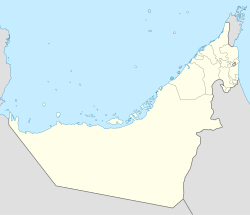 Jumeirah Archaeological Site Office and Exhibition Building | |
| Location | Dubai, the U.A.E. |
|---|---|
| Coordinates | 25°11′48″N55°14′30″E / 25.19679°N 55.24180°E |
| Area | Approximately 80,000 m2 (8.0 ha; 20 acres) [1] |
| Site notes | |
| Discovered | 1969 [1] |
The Jumeirah Archaeological Site is a site which dates back to the Abbasid period in the 10th century CE, in the district of Jumeirah in the city of Dubai, the United Arab Emirates. It was first excavated in 1969 with different ancient items including architectural and decorative findings, ranging from a mosque, caravanserai, and residential houses to glazed pottery jars and plateware, bronze coins, glass and stone artefacts. [1] [2] [3] It is owned and managed by Dubai Culture & Arts Authority.









